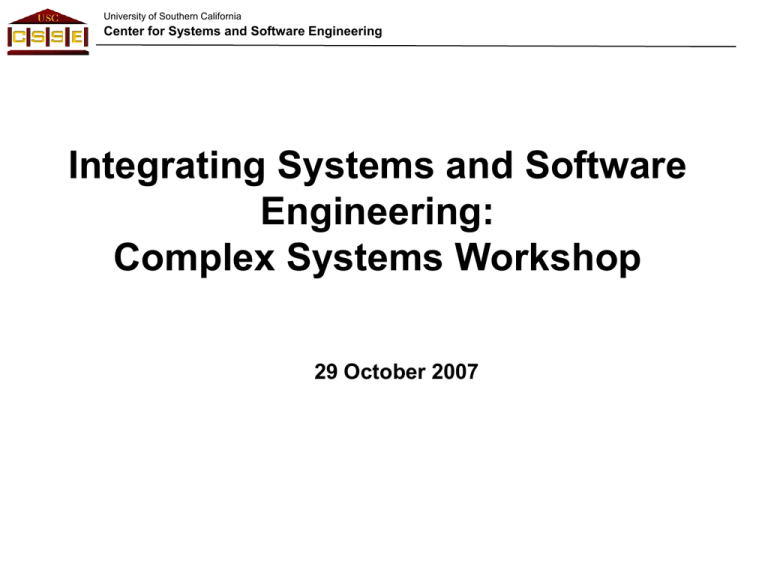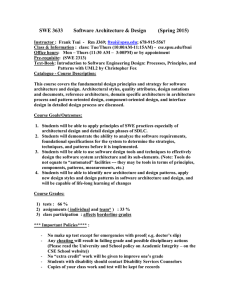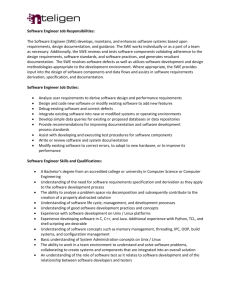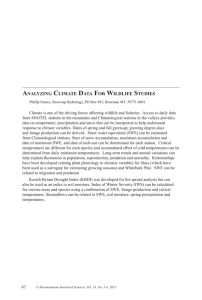Integrating Systems and Software Engineering Issues for Complex Systems
advertisement

University of Southern California Center for Systems and Software Engineering Integrating Systems and Software Engineering: Complex Systems Workshop 29 October 2007 University of Southern California Center for Systems and Software Engineering IS&SE Workshop Objectives: Identify • Biggest issues and opportunities? – In technology – In management – In complex systems • Inhibitors to progress and how to overcome them? • Ability of six principles to improve IS&SE? • Ability of Incremental Commitment Model to improve IS&SE? • What else is needed? – – – – Technology/management research Education and training Regulations, specifications and standards Other? October 2007 ©USC-CSSE 2 University of Southern California Center for Systems and Software Engineering Attendees • • • • • • John Rieff Tom Schroeder Kirstie Bellman Bruce Amato Bruce Kassan Barry Boehm October 2007 • • • • • • ©USC-CSSE Lee Whitt Darrell Maxwell Steven Wong Ali Nikolai Cynthia Nikoai Jo Ann Lane 3 University of Southern California Center for Systems and Software Engineering The Need for Three Different Conversations 1. What does SE mean for large, complex softwareintensive systems 2. What does SE/SWE integration mean when adding embedded systems, devices, hardware, networks 3. How are we going to deal with SE/SWE of more complex emergent systems of the future (later ) October 2007 ©USC-CSSE 4 University of Southern California Center for Systems and Software Engineering Biggest Issues • Lack of understanding by SE that SW provides enabling technology for system integration • SE needs to take broader role, stay involved across life-cycle • Key hard architecture problems require integrated SE/SWE approach – Ex. multi-level security issues (access rights); protection; resilience; non-functional requirements; quality attributes • Shared ownership of problems between SWE/SE • Architecture team needs to combine both SWE and SE background – How to support technically, managerially? In no specific order…. October 2007 ©USC-CSSE 5 University of Southern California Center for Systems and Software Engineering Fostering Shareable Viewpoints • Sharable representation and language between SE and SWE (shared models/artifacts, not just data dictionaries or boundary objects) • No guidance, process requirements for integrating systems and software workflows • Capture lessons-learned to avoid mistakes, repeat successes (specific examples TBS) • Development as collaboration among system elements, not traditional decomposition into functions • Need better methods to support the explicit tradeoffs among different partitioning of the system and different levels of resolution in order to support better reconciliation among SE/SWE In no specific order…. October 2007 ©USC-CSSE 6 University of Southern California Center for Systems and Software Engineering Incremental / Iterative Approach is Critical to SE/SWE Integration • Provide SE opportunity to experiment (and to fail), in order to understand feasibility • “Incremental/iterative” processes provide more frequent opportunities for SE / SWE touch-points – How to implement in large-scale systems? • Systems / HW / SW engineers must employ iterative methods (bunch of little V’s) In no specific order…. October 2007 ©USC-CSSE 7 University of Southern California Center for Systems and Software Engineering IS&SE for Complex Systems: General Issues • SE should adopt more modern develop paradigms • Commercial ROI vs DoD business model – Different incentives – Contractual / acquisition methods – Resulting in difficulty in adopting commercial practices for DoD systems • Key role: “software system engineer” specialty to bridge gap? • SWE/SE misunderstand respective roles and impacts of key decisions—Teams need to focus on – SE is more than defining Interfaces to appropriate levels of detail – Mission, orchestrating for global behaviors – Scalability In no specific order…. October 2007 ©USC-CSSE 8 University of Southern California Center for Systems and Software Engineering IS&SE for Complex Systems: Summary • Many key issues and opportunities discussed for current systems of today – Often based on example failures and successes • Concerns: Are fixes for systems of today going to be obsolete for systems of tomorrow? • Future efforts – Develop paper describing issues and opportunities in more detail – Follow-on workshops to develop opportunities further October 2007 ©USC-CSSE 9




